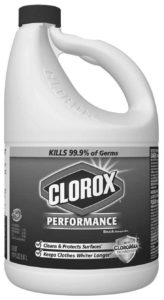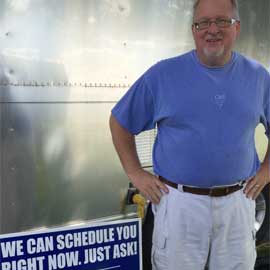How to sanitize your RV’s fresh water holding tank
While we know our RV’s black and gray holding tanks are dirty (they contain waste, after all), our freshwater holding tanks need regular and thorough cleaning too. Here’s the easy process to get your fresh water holding tanks so clean you can drink out of them.
One of the main complaints we hear about an RVer’s holding tanks is that the gray ones stink a lot. Sure, we expect the black tanks to have an odor, but what’s happening in the gray ones that are making everyone’s nose turn up?
Yuck, mold.
![]()
Quite simply, it’s mold. The inside of all of your RV’s holding tanks is an environment — especially in the summer or during other hot, humid weather — ripe for the growth of molds and odor-producing bacteria.
But it’s also a dirty fresh water holding tank that is also likely contributing to the problem.
If you use your fresh water holding tank at all, you need to sanitize it. How often? At least twice a year, no matter how often you use your RV. We like to do one right after we’ve de-winterized the RV and another mid-way through our RVing year.
If you are a full-timer or use your RV and it’s fresh water holding tank pretty frequently, then plan on sanitizing that tank three to four times a year, at a minimum. How do you do that?
The process is pretty simple.
![]()
You are basically going to get a diluted mixture of household bleach into your fresh water holding tank, pump it into throughout your RV’s water system, let it sit for a period of time, then pump it all out.
The active sanitation and disinfectant ingredient in bleach is sodium hypochlorite. It’s been used for centuries as a disinfectant and bleaching agent. Common, household bleach is a very diluted solution of sodium hypochlorite and, mostly, water. While not toxic, it can be very corrosive, even eating completely through stainless steel if left too long. It’s perfect for destroying bacteria, molds and mildews, and even most viruses.
To sanitize the water system in your RV, use a quarter cup (four ounces) of household bleach for every fifteen (15) gallons of water your fresh water tank holds. Some instructions will say to mix the bleach in a bucket or other container with fresh, potable water and then pour that into your fresh water holding tank. We think that makes a big mess that results in bleach on our clothes, hands, the side of the RV, and on the ground.
There’s a better way.
![]()

Household Clorox bleach works very well to sanitize your RV’s holding tanks (don’t use the splash-less kind, though). Want a great deal on bleach? Click the image to purchase it on Amazon.com.
Using your potable water hose (NOT a garden hose! — we’re talking about the special, white or blue water hose intended specifically to bring park or city water to your RV from the spigot at your site), pour the appropriate amount of bleach (quarter cup (four ounces) for every fifteen (15) gallons of capacity in your fresh water holding tank) into the empty water hose, connect the water hose to your RV’s fresh water tank inlet, and then fill the fresh water holding tank with potable water (which will also now have bleach in it).
Once full, briefly turn on every water tap, the shower head, and even flush the toilet in your RV until you detect a strong and distinct bleach smell from each water source. This ensures that the pipes and other fixtures have bleach in them; your entire fresh water system needs to have this mild bleach-water solution in contact with it.
The guideline is to let your RV’s plumbing system and fresh water tank (now nearly full of bleach-y water) for a minimum of four (4) hours. We like to leave it overnight.
Once that time period has passed, pump out the water from your RV’s fresh water tank through the waste disposal system (from each water tap, the shower head, toilet, etc.), into the holding tanks and then empty them thoroughly. We recommend that you fill each of your holding tanks again with fresh, clean water and then empty it again to remove any remaining bleach solution.
Refill your RV’s fresh water tank with clean, potable water. No bleach this time. Let it sit for an hour. Then pump it all through the system again and empty those holding tanks one last time. Your RV’s water system is now sanitized. Now, wasn’t that easy?!
Some precautions.
![]()
Splash-less bleach is a little thicker than regular, household bleach. The active ingredient, sodium hypochlorite, only has a one to five percent concentration, not enough to sanitize and disinfect, as the label on the bottle will warn. Use regular, household bleach (that doesn’t say “splash-less”) instead.
Household bleach, as we mentioned, can be extremely corrosive. It’s important to wipe down any surfaces that it may have spilled on with water or ethanol and definitely avoid letting bleach stay in contact with delicate metal instruments or structures (such as your holding tank’s sensor probes) for very long.
Bleach can also damage rubber or plastic parts and surfaces, such as water supply and waste disposal plumbing pipes, holding tank seals, and other soft, delicate parts in your RV. Rinsing away and disposing of the diluted bleach-water solution used to sanitize your RV’s fresh water holding tanks is a critical last step.
Bleach also degrades quickly, especially when exposed to sunlight. Always store bleach in a cool, dry environment in thick, opaque plastic (like the one it comes in!) or glass bottle. Never mix bleach and ammonia-based cleaners. Doing so will create toxic chloramine gases and an explosive called nitrogen trichloride. Yikes!

Jim Tome, Owner
Hi, I'm Jim Tome and, along with my wife, Debbie, the owners of Kleen Tank LLC, the national leader in RV holding tank cleaning service. We've been RVers like you since 2004 and have traveled all over the U.S. in our Airstream travel trailer. We started the business about twelve years ago and have cleaned tens of thousands holding tanks in thousands of RVs. From tiny weekend travel trailers to monstrous fifth wheels to luxurious motorhomes, I've seen just about every situation there is with RV holding tanks and waste systems. I hope you enjoy our articles; I try to post at least one per week and we've got a great library of them to cover just about every problem. Enjoy!
Keep in mind that we may receive commissions when you click our links and make purchases. However, this does not impact our reviews and comparisons. We try our best to keep things fair and balanced, in order to help you make the best choice for you.
MAKE A QUICK INQUIRY
WE'LL GET RIGHT BACK TO YOU
WE'RE HERE FOR YOU
CONNECT WITH US
844-KLEENME (844-553-3663)
info@KleenTank.com
Facebook.com/KleenTank
Instagram.com/KleenTank
WHAT DOES OUR SERVICE DO?
IT'S PRETTY SIMPLE...
Fixes and corrects your RV's tank sensors almost every time.
Features innovative, hydrojetting technology.
Is a 100% mobile service. We come to you at your site.
Is environmentally safe and makes no mess at your site.
Is chemical-free and all-natural.

0 Comments